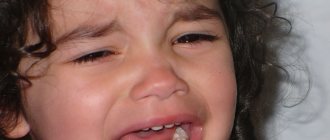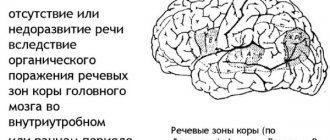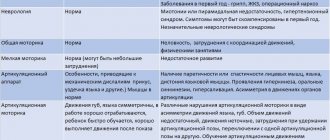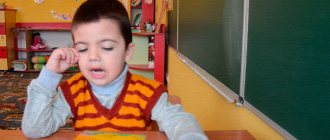Diagnosis of dyslalia
If parents notice that a child by the age of 5 does not pronounce a number of sounds, or pronounces them distortedly and incorrectly, the best decision in this case would be a consultation with a speech therapist.
The speech therapist conducts an examination of sound pronunciation using special picture material. This procedure is carried out individually and/or in the presence of the child’s parents or legal representatives.
The material for examining sound pronunciation includes sets of pictures for different groups of sounds. The selection of subject pictures is made in such a way that each of the sounds being examined is at the beginning, middle or end of the name word, since the sound is pronounced differently in different positions. Pronunciation is checked using visual material:
- in the group of whistling consonants [s] [s'] [z] [z'] [ts];
- in the group of sibilant consonants [w] [zh] [sh'] [h];
- in the group of sonorant consonants [р] [р'] [л] [л'] [j] [ja] [je] [jo] [jy] [ji];
- in the group of back-lingual consonants [k] [k'] [g] [g'] [x] [x'];
- in the group of voiced consonants [v] [v'] [b] [b'] [d] [d'];
- in the group of voiceless consonants [f] [f'] [p] [p'] [t] [t'].
The speech therapist selects at least three pictures for each sound position in the word (at the beginning, middle, end).
When examining sound pronunciation, the speech therapist notes the absence, replacement, confusion, and distortion of sound. If the child finds it difficult to name the picture, the speech therapist suggests repeating the word after him (i.e., reflected).
During a speech therapy examination, the specialist pays attention to and records:
- features of speech tempo;
- clarity of words pronunciation;
- correct pronunciation of words (by syllable structure);
- sonority of voice.
Important to remember! At the “Easy to Speak” speech development center, it is possible to undergo a comprehensive speech therapy examination and obtain a specialist opinion.
Topic 2. The place of dyslalia in the general system of classification of speech disorders
Discipline
“Speech therapy. Part 1. Dislalia"
Training module 1.
History of the study of dyslalia. Place of dyslalia in general
System of classifications of speech disorders.
Study module plan
The theoretical material of the first module is preliminarily studied by students independently before the first videoconference. During the first videoconference, students conduct an interactive interview with the teacher on assignments for practical work.
Theoretical material
Modules on the subject “Speech Therapy” in a condensed version convey the content of the main textbook “Speech Therapy” edited by L.S. Volkova and S.N. Shakhovskaya. When preparing for the exam, you must also use the primary source and additional literature.
Topic 1. Definition, history of study, symptoms of dyslalia
Dyslalia (from the Greek dis - a prefix meaning partial disorder, and lalio - I say) is a violation of sound pronunciation with normal hearing and intact innervation of the speech apparatus.
Among the violations of the pronunciation aspect of speech, the most common are selective violations in its sound (phonemic) design with the normal functioning of all other utterance operations.
These disorders manifest themselves in defects in the reproduction of speech sounds: distorted (abnormal) pronunciation, replacement of some sounds with others, mixing of sounds and, less often, omissions.
The term “dyslalia” was one of the first in Europe to be introduced into scientific circulation by Vilnius University professor doctor I. Frank. In a monograph published in 1827, he used it in a generalized sense as the name of all types of pronunciation disorders of various etiologies. Somewhat later, in the 30s of the 19th century, the Swiss doctor R. Schulthess also introduced the term “dyslalia” into his works, but in a narrower meaning than that of I. Frank: he classifies as dyslalia only pronunciation disorders caused by anatomical defects organs of articulation. In Kussmaul's classification, Schulthess' point of view was adopted, and the same understanding of dyslalia is found in the works of Gutzmann.
A slightly different position was taken by the Polish researcher V. Oltushevsky, who classified cases of pronunciation disorders that were not caused by anatomical defects of the speech apparatus as dyslalia. He distinguished two forms: functional and caused by hearing loss (dislalia audiogenes). He designated pronunciation defects caused by pathological changes in the articulatory apparatus with the term “dysglosia” and identified four types of this defect depending on which of the articulatory departments is impaired: labialis, lingualis, dentalis and palatal. (palatalis).
In domestic speech therapy at the beginning of the 20th century. the scope of the concept of dyslalia did not differ from that adopted in the works of Kussmaul and Gutzmann. But already in the 30-50s this concept underwent significant changes. M.E. Khvattsev considered dyslalia as one of the forms of tongue-tiedness (all types of pronunciation disorders were included under this general term). It included sound pronunciation disorders caused by damage or disorder of the peripheral organs of speech: musculoskeletal parts, or “peripheral or innervation,” as well as sound pronunciation disorders caused by peripheral hearing loss. He believed that at least 10% of cases of dyslalia are due to this defect. M. E. Khvattsev identifies three forms of dyslalia: mechanical, caused by gross anatomical defects of the speech organs (cleft palate, short hyoid frenulum); organic, caused by peripheral hearing loss, abnormalities of the jaws, teeth, tongue and palate; functional, caused by muscle laxity of the soft palate, insufficient flexibility of the tip of the tongue, weakness of the exhaled air stream, etc.
In the early 50s, A. M. Smirnova, based on large clinical material, published a classification of pronunciation defects, which differs markedly from the classification proposed by M. E. Khvattsev.
At the same time, O. V. Pravdina gives a different interpretation of dyslalia: in particular, disorders caused by hearing defects were excluded. Unlike M.E. Khvattsev, she identified only two forms: functional and mechanical, the latter also included rhinolalia.
Subsequently, in the 60s, in the works of S. S. Lyapidevsky and O. V. Pravdivaya, there was a tendency to divide pronunciation defects into dysarthria and dyslalia and abandon the general term “tongue-tied”. During these same years in
In the work of S. S. Lyapidevsky and B. M. Grinshpun, rhinolalia was separated from mechanical dyslalia into a separate speech disorder. This in a certain way narrowed the concept of dyslalia and made it more clear. Subsequently, the division of dyslalia into functional and mechanical began to be shared by most authors. Only in individual works did organic dyslalia begin to be mentioned, although the content of this phrase did not coincide among all authors: in the work of E. F. Pay and V. A. Sinyak, the term “organic dyslalia” was simply replaced by the term “mechanical dyslalia,” and in the work of L. V. Melekhova, the concept of “organic dyslalia” covered cases of pronunciation disorders, transitional between dysarthria and dyslalia. Recently, such disorders are defined as erased dysarthria.
Currently, the term “dyslalia” has acquired an international character, although its content, as well as the types of violations it defines, do not always coincide. These discrepancies are related to the basis that researchers take when describing disorders: anatomical-physiological, psychological or linguistic. In traditional descriptions that use clinical criteria, various pronunciation disorders such as dyslalia are often considered as adjacent. Descriptions based on psychological and linguistic criteria include in the concept of dyslalia either its various forms and types, or phonetic and phonetic-phonemic violations of sound pronunciation (for example, in the works of R. E. Levina).
A critical analysis of the doctrine of dyslalia from modern scientific positions requires a revision of established ideas in speech therapy. Pronunciation defects are often different in their neurophysiological and psychological mechanism, in the reasons that cause them, in their role in the child’s overall speech development and methods of overcoming them.
Dyslalia is one of the most common pronunciation defects. Statistical data from domestic and foreign researchers indicate that 25-30% of preschool children (5-6 years old) and 17-20% of school-age children (grades I-II) have pronunciation deficiencies. For older students, pronunciation deficiencies account for no more than 1%. This indicates that there are temporary disturbances that are overcome during the speech development of children and in the process of schooling.
Topic 2. The place of dyslalia in the general system of classification of speech disorders
Scientifically based ideas about the forms and types of speech disorders are the starting conditions for the development of effective methods for overcoming them. Throughout the history of the development of speech therapy, researchers have strived to create a classification of speech disorders that covers all their diversity.
Currently, in domestic speech therapy there are two classifications of speech disorders in circulation, one is clinical-pedagogical (CPC), the second is psychological-pedagogical (PPK), or pedagogical (according to R. E. Levina).
According to the clinical and pedagogical classification, dyslalia is included in the group of oral speech disorders and in the subgroup of “violations of the phonation (external) design of utterances,” which are called disorders of the pronunciation side of speech.
Disorders of the phonation design of an utterance can be differentiated depending on the disturbed link: a) voice formation, b) tempo-rhythmic organization of the utterance, c) intonation-melodic organization, d) sound-pronunciation organization. These disorders can be observed in isolation and in various combinations.
IN DISLALIA, ONLY THE SOUND PRONUNCIATION ORGANIZATION SUFFERS (diction, formation of sounds)!
This means that a person with dyslalia develops a normal lexical and grammatical structure and does not have general pronunciation disorders (tempo, rhythm, intonation, voice strength, etc.).
Sound pronunciation defects in dyslalia can be combined with stuttering, other tempo-rhythmic disturbances, dysphonia, and written speech disorders.
Sound pronunciation also suffers with OHP, but in this case this defect is part of the general signs of underdevelopment of the speech system (along with vocabulary and grammar), therefore these two formulations (dyslalia and OHP) cannot stand in parallel in the speech therapy report.
It is important to distinguish dyslalia from other phonation disorders - dysarthria (when the innervation of the muscles of the speech apparatus is impaired), rhinolalia (there are gross defects in the structure of the articulatory apparatus or other organic causes leading to a violation of the velopharyngeal resonance).
In the psychological and pedagogical classification, the term “dyslalia” is not used. Violations of sound pronunciation according to the PPK are included in the group of violations of the means of communication - FPN (phonetic-phonemic disorders) or FN (phonetic underdevelopment).
Speech therapists of the healthcare system use the term “dyslalia” in their conclusions, since they rely on ICD 10 - the International Classification of Diseases, Tenth Revision, which also enshrines this term.
Speech therapists of the educational system, when issuing a speech therapy report, traditionally rely initially on the psychological and pedagogical classification and primarily use the term FN or FFN (depending on the structure of the defect).
Correction of dyslalia
Speech therapy work to correct dyslalia consists of the following stages:
- Examination of a child’s sound pronunciation;
- Correction of impaired speech sounds:
- Development of articulatory motor skills;
- Formation of skills in distinguishing speech sounds based on acoustic and articulatory features (work on phonemics);
- Production of disturbed sounds;
- Automation and introduction of formed sounds into speech.
The following stages are distinguished in the work on correcting sound pronunciation:
- Preparatory;
- Sound production;
- Sound automation;
- Sound differentiation.
The purpose of the preparatory stage is to prepare the organs of the articulation apparatus for the pronunciation of sounds: at this stage, the accuracy, strength and differentiation of movements of the articulation organs are worked out; work is underway to develop speech exhalation. At the preparatory stage, the child learns to perform articulatory gymnastics exercises, as well as various breathing exercises.
Important to remember! There is a basic set of exercises for developing the basic movements and position of the organs of the articulatory apparatus. Additional sets of exercises necessary for staging certain groups of sounds are selected for the basic complex.
Important to remember! Exercises to develop speech breathing help children develop targeted exhalation, which is necessary for mastering difficult-to-pronounce sounds.
Instructions for performing articulation gymnastics, as well as a list of exercises, can be read in our article
Video of articulation gymnastics:
Photos and videos of breathing exercises
Forms: mechanical and functional dyslalia
Mechanical
(organic) dyslalia is caused by anatomical defects in the structure of the organs of the speech apparatus. The causes of such defects can be either congenital or acquired. Damage to the bone or muscle structure of the peripheral speech apparatus occurred due to hereditary factors, birth trauma or trauma in the postnatal period. Such damage includes:
1) anomalies of the dentofacial system:
– gap between the front teeth;
– absence of teeth or their distortion: location outside the jaw arch, growing with a turn, tilt, rotten, crooked, incomplete jaw;
– defects in the structure of the jaws: prognathia – the upper jaw is sharply pushed forward, hanging over the lower jaw; progeny - the lower jaw protrudes sharply forward; bite defects – deep, open (front, lateral, bilateral, cross). When malocclusion occurs, the function of the masticatory system suffers, and breathing is often impaired. In combination with dental defects, signs such as squelching, whispering, and smacking appear.
2) irregular structure of the sky: high, gothic, narrow, flat. With this structure, the correct pronunciation of hissing, whistling and sonorant sounds suffers, since the tongue has to be raised higher. For the same reason, speech becomes slurred.
3) pathological distortion of the size and shape of the tongue:
– very small tongue – microglossia;
– too large tongue – macroglossia;
– wide and short;
– narrow and subtle tongue;
– shortened hyoid frenulum. In this case, the pronunciation of the sounds [р] and [р'] is disrupted.
4) lip defects: thin, thick, sedentary, massive, narrow. This leads to incorrect pronunciation of labial, labiodental and labialized vowel sounds.
Functional dyslalia
– in the absence of organic lesions of the central nervous system and articulation organs, the child distorts sounds because he has learned them incorrectly. The pronunciation of one or more sounds may be impaired for various reasons.
- Biological factors.
– general muscle weakness due to somatic diseases, especially during the sensitive period of speech formation.
– minimal brain dysfunction resulting in mental retardation.
– delayed appearance of speech, slight impairment of phonemic perception.
– decreased physical hearing during a period sensitive to speech.
2. Social factors. During the period of speech formation, the child had an unfavorable social environment; adults themselves had speech defects or made grammatically incorrect statements. Perhaps there was a limitation of speech contacts, bilingualism in the family, or adults lisped excessively and did not correct the child’s distorted pronunciation. The lack of development of sound means of communication also depends on nutrition. If a child under two years of age was fed liquid soft food, products softened in a blender, deliberately avoiding solid foods, such as pieces of meat, potatoes, bread, cookies, which must be chewed thoroughly, then his chewing function was underdeveloped, the muscles of the tongue were not sufficiently strengthened, which directly affects the pronunciation of certain sounds. First of all, this applies to the back lingual sounds [k], [g], [x] and their soft variants.
Sound production stage.
The goal of this stage is to develop the initial skills of correctly pronouncing a sound and is achieved in two ways:
- By imitation;
- With mechanical assistance.
The production of sound with mechanical assistance depends on the characteristics of its articulation. Probes, spatulas, and probe substitutes can be used as mechanical assistance.
Video: setting the sound p
Important to remember! The production of sounds should be carried out by a speech therapist exclusively in the conditions of individual work with the child.
Types of Pronunciation Disorders
Violations of sound pronunciation can be of the type of distortion, confusion or replacement. Distortion –
the process of irregular pronunciation of a sound in all positions in a word due to the lack of formation of the correct articulatory position. Speech sounds acquire a sound that is unusual for the native language: the sound [s] can be hissing, [ts] can be wheezing.
Mixing
- a process when a child has well-formed and practiced all articulatory positions, but he does not know how to distinguish some of these positions, so the pronunciation of sounds is mixed, the same word can have different sounds.
Replacement
– a condition when a child confuses sounds that are the same in the method of formation, but different in the place of articulation, or vice versa. He also replaces hard consonants with soft ones, whistling ones with hissing ones, instead of [w] he says [s], instead of [zh] - [z], instead of [r] - [l].
Substitutions and mixing of sounds occur for the following reasons:
– acoustic-phonemic – the child does not fully hear the sound, cannot recognize it in the sensory level, and then it is difficult for him to process it into the correct pronunciation. For example, instead of “cat” he says “that”, “goth” - “cat”, etc.
– articulatory-phonemic – the child cannot establish the correct articulatory posture when pronouncing a sound. For example, when pronouncing the sound [s], the lips should be parted in a smile, the teeth should be exactly above each other (“Fence”), there should be a small gap between the teeth, and the tongue should rest against the lower teeth. And the child stretches his lips forward with a tube, so it turns out [s] with a hiss. Due to insufficient development of articulatory positions, the child looks for the easiest and most accessible pose for him. Or another reason: the child has correctly developed all articulation patterns, but he cannot differentiate some sounds. This gives rise to three levels of sound pronunciation impairment:
- Incorrect pronunciation of a sound or group of sounds in different positions, in isolation, in syllables, words and phrases.
- Pronunciation of isolated sounds is correct and incorrect in words, phrases and sentences.
- Correct pronunciation of sounds in words and phrases, but mixing them with other sounds in the flow of speech.
The above levels correspond to three stages of working on sound: staging, automation and differentiation. Substitutions and mixtures most often occur between sounds that differ only in one attribute: whistling and hissing (Shasha-Sasha), plosive front-lingual and back-lingual (Tatya-Katya), hard and soft (bear-mouse), sonorants (Roma-Loma) and etc. Substitutions and confusions are often reflected in written language.
Sound automation stage.
Automation of sounds is carried out consistently, through repeated training. Sound automation procedure:
- Isolated utterance;
- In syllables:
- in straight syllables (consonant + vowel);
- in reverse syllables (vowel + consonant);
- between vowels (vowel + consonant + vowel);
- in conjunction with a consonant sound (consonant + consonant + vowel);
- In words;
- In phrases;
- In sentences;
- In the text;
- In tongue twisters, pure tongue twisters, in your own speech.
Video: sound automation L







